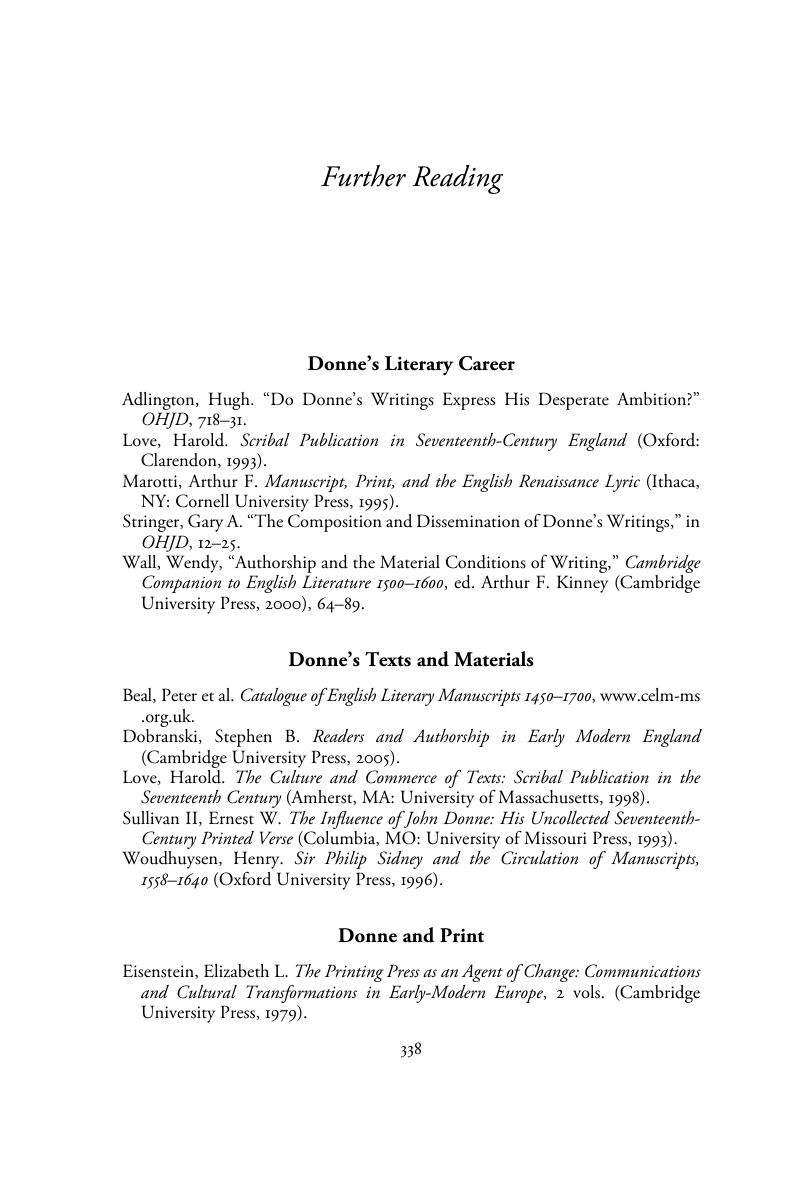Book contents
- John Donne in Context
- John Donne in Context
- Copyright page
- Dedication
- Contents
- Illustrations
- Notes on Contributors
- Acknowledgments
- Chronology
- Abbreviations
- Introduction
- Chapter 1 Donne’s Literary Career
- Chapter 2 Donne’s Texts and Materials
- Chapter 3 Donne and Print
- Chapter 4 Language
- Chapter 5 Donne’s Poetics of Obstruction
- Chapter 6 Elegies and Satires
- Chapter 7 The Unity of the Songs and Sonnets
- Chapter 8 Divine Poems
- Chapter 9 Letters
- Chapter 10 Orality and Performance
- Chapter 11 Reading and Interpretation
- Chapter 12 Education
- Chapter 13 Law
- Chapter 14 Donne’s Prisons
- Chapter 15 Donne and the Natural World
- Chapter 16 Money
- Chapter 17 Sexuality
- Chapter 18 Donne and the Passions
- Chapter 19 Pain
- Chapter 20 Medicine
- Chapter 21 Science, Alchemy, and the New Philosophy
- Chapter 22 Donne and Skepticism
- Chapter 23 The Metaphysics of the Metaphysicals
- Chapter 24 Controversial Prose
- Chapter 25 Devotional Prose
- Chapter 26 The Sermons
- Chapter 27 The Self
- Chapter 28 Portraits
- Chapter 29 Donne in the Seventeenth and Eighteenth Centuries
- Chapter 30 Donne in the Nineteenth and Twentieth Centuries
- Chapter 31 Donne in the Twenty-first Century:
- Further Reading
- Index
- References
Further Reading
Published online by Cambridge University Press: 26 April 2019
- John Donne in Context
- John Donne in Context
- Copyright page
- Dedication
- Contents
- Illustrations
- Notes on Contributors
- Acknowledgments
- Chronology
- Abbreviations
- Introduction
- Chapter 1 Donne’s Literary Career
- Chapter 2 Donne’s Texts and Materials
- Chapter 3 Donne and Print
- Chapter 4 Language
- Chapter 5 Donne’s Poetics of Obstruction
- Chapter 6 Elegies and Satires
- Chapter 7 The Unity of the Songs and Sonnets
- Chapter 8 Divine Poems
- Chapter 9 Letters
- Chapter 10 Orality and Performance
- Chapter 11 Reading and Interpretation
- Chapter 12 Education
- Chapter 13 Law
- Chapter 14 Donne’s Prisons
- Chapter 15 Donne and the Natural World
- Chapter 16 Money
- Chapter 17 Sexuality
- Chapter 18 Donne and the Passions
- Chapter 19 Pain
- Chapter 20 Medicine
- Chapter 21 Science, Alchemy, and the New Philosophy
- Chapter 22 Donne and Skepticism
- Chapter 23 The Metaphysics of the Metaphysicals
- Chapter 24 Controversial Prose
- Chapter 25 Devotional Prose
- Chapter 26 The Sermons
- Chapter 27 The Self
- Chapter 28 Portraits
- Chapter 29 Donne in the Seventeenth and Eighteenth Centuries
- Chapter 30 Donne in the Nineteenth and Twentieth Centuries
- Chapter 31 Donne in the Twenty-first Century:
- Further Reading
- Index
- References
Summary

- Type
- Chapter
- Information
- John Donne in Context , pp. 338 - 347Publisher: Cambridge University PressPrint publication year: 2019

